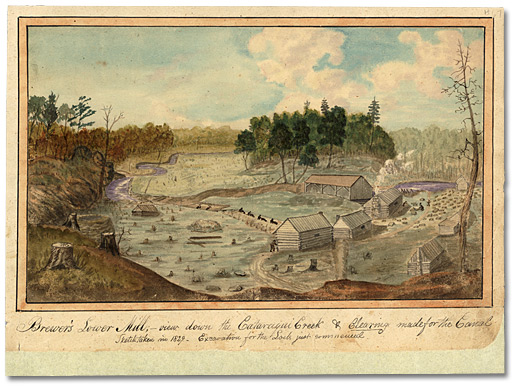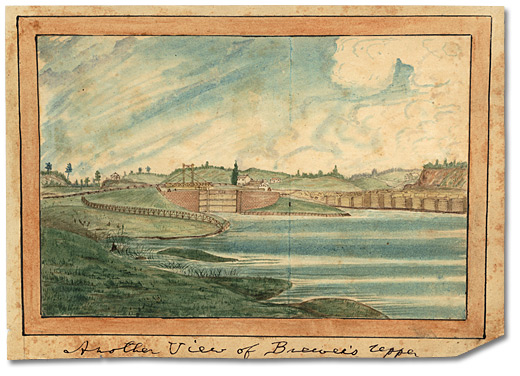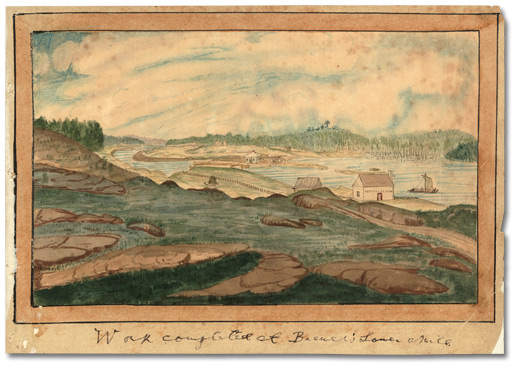
Welcome Improvements

Click to see a larger image (356K)
Brewer's Lower Mill; View down the Cataraqui Creek, & and
Clearing made for the Canal. Excavation for the Lock just commenced, 1829
Watercolour
Thomas Burrowes fonds
Reference Code: C 1-0-0-0-67
Archives of Ontario, I0002186
Unwelcome Improvements
Surveyors and engineers were not always the first people to arrive at a lock site with ambitious plans. Mills already existed at a number of sites, and Lieutenant-Colonel John By (commandant of the works) usually tried to route his lock works around them. Often local residents and mill owners – anxious to find work on the project or to benefit from improved transportation – accommodated the canal construction by selling out. When By could purchase milling operations, he usually tore down the facilities and replaced them with dams, weirs and locks. That was not the case at Brewer’s Lower Mill, however, a location that Thomas Burrowes painted three times throughout construction. There, persistent trouble erupted with the local landowner, whose mill is mysteriously absent from Burrowes’s first painting: it should have been visible above the rapids on the left side of the painting.
Burrowes’s first painting (1829) shows the clearing that would eventually house the lockstation. Behind the log storage buildings and barracks, the curving river is visible, and men with wheelbarrows are removing soil for the eventual lock pit.
Trouble With the Locals
A Colonel McLean was well established at Brewer’s Lower Mill when construction began in 1827. Rather than welcoming progress, an angry McLean flooded the site four times in order to bring work to a halt.
Local contractor Samuel Clowes complained to By in July 1827 that,
“I have nothing but trouble, Colonel McLean is doing all he can to put a stop to the Canal, he has overflowed the whole work 4 times and me and eighty men have had to stand for two or three days’ each time till the water was drained off, and there it leaves the land all mud; and makes it so sickly it is not possible to keep labourers on the ground.”
Guards were posted around the site, but eventually the colonel sold the mill, allowing the engineers to make better use of the site.

Click to see a larger image (334K)
Another View of Brewer's Upper Mills, 1830
Watercolour
Thomas Burrowes fonds
Reference Code: C 1-0-0-0-66
Archives of Ontario, I0002185
Three years later, Burrowes captured the almost completed lock walls and clearly showed how hand-cranked winches were used in combination with ropes and tripods to lift materials into place. To the left, a work crew begins the onerous task of making navigation easier in front of the lock by dredging out a section of the river bank. In this view, looking upstream, McLean’s original mill is clearly visible above the rapids.

Click to see a larger image (322K)
Work completed at Brewer's Lower Mills, 1832
Watercolour
Thomas Burrowes fonds
Reference Code: C 1-0-0-0-69
Archives of Ontario, I0002188
By the end of 1832, the lockstation was complete and Burrowes, looking downstream, celebrates its success by portraying a loaded raft leaving the lock under sail (on the right). A weir beyond the lock (behind the lockmaster’s house in the centre of the painting) has flooded a marsh and the original mill is no longer visible.